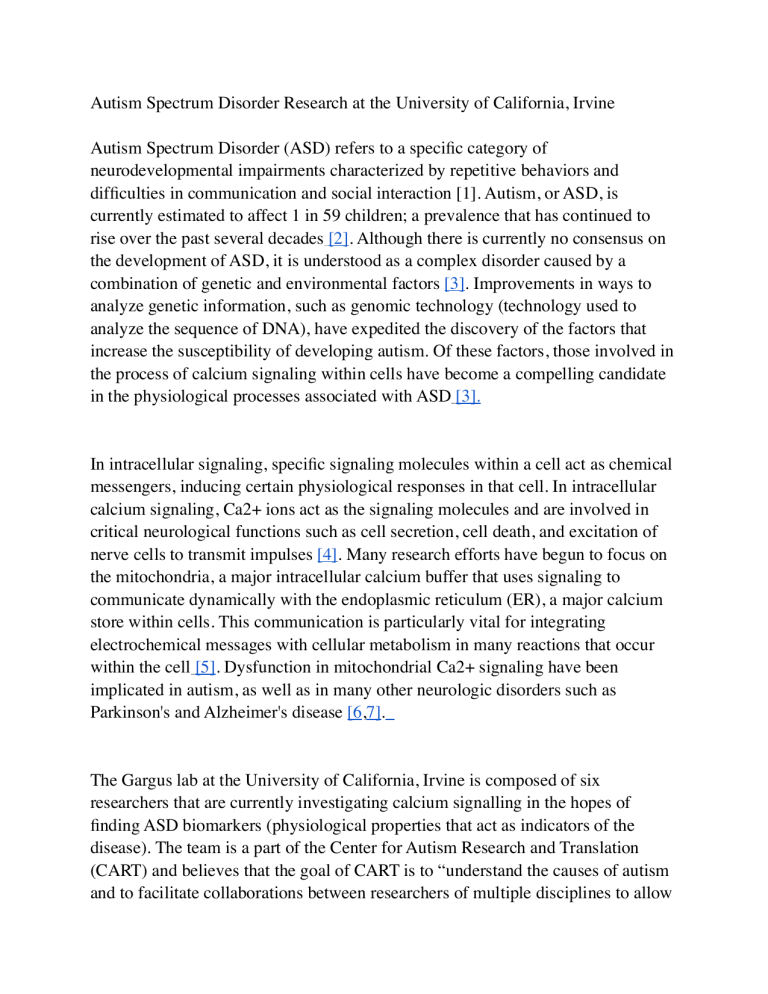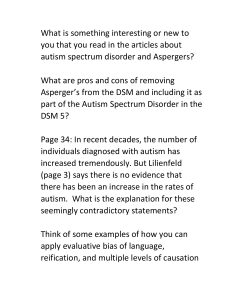
Autism Spectrum Disorder (ASD) refers to a speci c category of neurodevelopmental impairments characterized by repetitive behaviors and dif culties in communication and social interaction [1]. Autism, or ASD, is currently estimated to affect 1 in 59 children; a prevalence that has continued to rise over the past several decades [2]. Although there is currently no consensus on the development of ASD, it is understood as a complex disorder caused by a combination of genetic and environmental factors [3]. Improvements in ways to analyze genetic information, such as genomic technology (technology used to analyze the sequence of DNA), have expedited the discovery of the factors that increase the susceptibility of developing autism. Of these factors, those involved in the process of calcium signaling within cells have become a compelling candidate in the physiological processes associated with ASD [3]. In intracellular signaling, speci c signaling molecules within a cell act as chemical messengers, inducing certain physiological responses in that cell. In intracellular calcium signaling, Ca2+ ions act as the signaling molecules and are involved in critical neurological functions such as cell secretion, cell death, and excitation of nerve cells to transmit impulses [4]. Many research efforts have begun to focus on the mitochondria, a major intracellular calcium buffer that uses signaling to communicate dynamically with the endoplasmic reticulum (ER), a major calcium store within cells. This communication is particularly vital for integrating electrochemical messages with cellular metabolism in many reactions that occur within the cell [5]. Dysfunction in mitochondrial Ca2+ signaling have been implicated in autism, as well as in many other neurologic disorders such as Parkinson's and Alzheimer's disease [6,7]. fi fi The Gargus lab at the University of California, Irvine is composed of six researchers that are currently investigating calcium signalling in the hopes of nding ASD biomarkers (physiological properties that act as indicators of the disease). The team is a part of the Center for Autism Research and Translation (CART) and believes that the goal of CART is to “understand the causes of autism and to facilitate collaborations between researchers of multiple disciplines to allow fi fi Autism Spectrum Disorder Research at the University of California, Irvine Today, the team is focusing their attention on calcium ions as biologic markers for ASD. Rachel noted that “much of our recent research has pointed to a dysfunction in IP3-mediated calcium signaling as an indicator for the disorder and our ndings that identi ed this dysfunction can be further developed into more intricate cell studies to study the exact chemical mechanisms involved in producing the physical attributes in autistic individuals” [8]. Although there is a plethora of people conducting research on autism with many different causes being looked at, the Gargus lab is one that is set apart from the rest. Unlike many labs worldwide, the Gargus lab has the unique advantage of being a part of CART and being one of the few “labs who are speci cally focused on calcium signaling networks in autism” [8]. However, it is not about who nds the biomarker rst, but rather about collaborative efforts with institutions and labs worldwide. fi fi fi fi fi fi fi fi fi fi fi Autism is a highly complex disorder. The diversity of its physical characteristics and genetic makeup has made it extremely dif cult to study and develop correlations between speci c genes and how they manifest physically. However, Rachel believes that “advancements in genetic sequencing and neurotechnology may allow us to overcome many of the limitations in research that we have previously encountered” [8]. Whether it is looking into calcium signaling or nding a genetic biomarker, one thing is for certain, the combination of works fi fi fi us to take novel approaches that uniquely distinguishes our facility from other research institutions” [8]. Previously, the Gargus lab used specialized microscopy to test broblast cells derived from skin samples of patients who had autism due to a single defective gene. Fibroblast cells, which are commonly found in connective tissue, produce important structural bers. The results of the study showed that the release of calcium from the ER through speci c calcium channels was impaired in the tested broblast cells [9,10]. In a current ongoing study, the Gargus lab is now investigating whether this impaired intracellular Ca2+ signalling is also affected by a dysfunction in mitochondrial activity. Through this study, the Gargus lab hopes to nd a genetic biomarker for ASD and further improve our knowledge of the mechanisms behind the disease. Rachel Nguyen, a member of the lab, was able to sit down with us and discuss the study and its signi cance. from those all around the globe and their collaborative efforts are bringing the world one step closer to identifying the indicators of autism. References: Nguyen, R. (2017) Connecting genetic calcium channel variants to molecular pathways in pathogenesis of Autism Spectrum Disorders. Proposal. 1: 1-3. 2. “Autism Spectrum Disorder (ASD).” Center for Disease Control and Prevention, 26 April 2018, https://www.cdc.gov/ncbddd/autism/data.html 3. Chaste, P. Marion, L. (2012) Autism risk factors: genes, environment, and gene-environment interactions. Dialogues in clinical neuroscience, 14:281-291. 4. Zundorf, G., Resier, G., (2011) Calcium Dysregulation and Homeostasis of Neural Calcium in the Molecular Mechanisms of Neurodegenerative Diseases Provide Multiple Targets for Neuroprotection. Antioxidants & Redox Signaling, 14:1275-88. 5. Gargus, J. J. (2009). Genetic calcium signaling abnormalities in the central nervous system: seizures, migraine, and autism. Annals of the New York Academy of Sciences, 1151:133-156. 6. Giorgi, C., Agnoletto, C., Bononi, A., Bonora, M., De Marchi, E., Marchi, S., Pinton, P. (2012). Mitochondrial calcium homeostasis as potential target for mitochondrial medicine. Mitochondrion. 12:77-85. 7. Chunyan, G., Li, S., Xueping, C., Danshen, Z. (2013) Oxidative stress, mitochondrial damage and neurodegenerative diseases. Neural Regeneration Research. 8:2003-2014. 8. Nguyen, Rachel. Personal interview. 25 Nov. 2018. 9. Schmunk, G., Boubion, B., Smith, F., Gargus, J. (2015) Shared functional defect in IP3R-mediated calcium signaling in diverse monogenic autism syndromes. Translational Psychiatry. 5:643. 10. Schmunk, G., Nguyen, R., Ferguson, D., Kumar, K., Parker, I., Gargus, J. (2017) High-throughput screen detects calcium signaling dysfunction in typical sporadic autism spectrum disorder. Scienti c Reports. 7:40740. fi 1.


